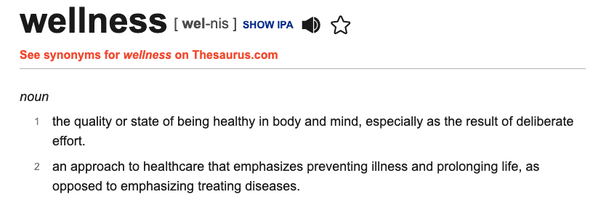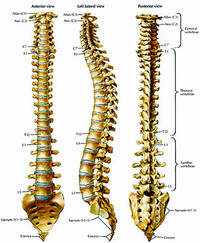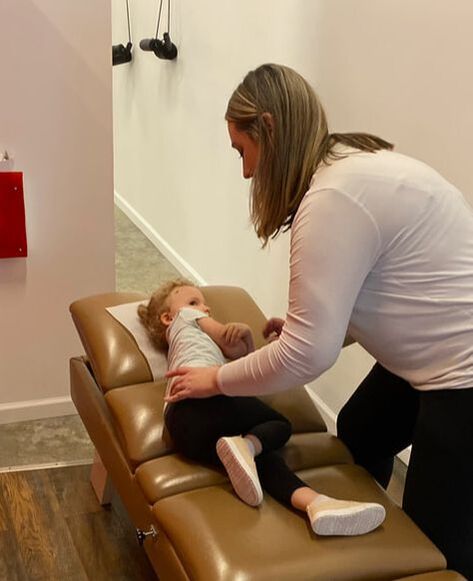 Wellness is a word that gets thrown around a lot these days. But what does that really mean? Are we actually doing the right things for the sake of wellness? I would argue that the term wellness gets misused a lot, though. Many times it is used synonymously with the absence of symptoms. But true wellness is defined as: Wellness is all about working preemptively on your health to avoid health crises and add quality to your life. This makes wellness chiropractic care a no-brainer because chiropractic works through removing interference in the nervous system, allowing the body to function as best it can. A lot of times I hear things similar to “if it’s not broken, don’t fix it” as a reason not to receive consistent chiropractic care. People “feel fine” but not having symptoms really only means that you haven’t reached a point yet where you have developed symptoms. Which is why it is important to get your spine checked; if you have a reduced cervical curve you are actively working toward dysfunction and disease. Depending on whether or not you are in touch with your body you could never feel pain at all and still have degenerative processes affecting your spine. I also frequently hear people talk about the cost of chiropractic care. Usually it's because we were taught our whole lives that you only have to think about your health in the broad "eat right and exercise" frame of mind. In that model you don't take actions for your health until you've encountered an issue to fix. The problem with this mindset is that oftentimes you are not actually healthy, you're just not sick yet. Health should be an investment. If you've ever heard the phrase GIGO (or the alternative, BIBO) you know that it stands for Good In, Good Out. You also know that it means that what you put in, you get out. We usually use this concept for relationships or work ethic but it fits PERFECTLY with your health and wellness. When you put in good input, every single day, your body is going to reward you with good output. You will be full of energy, fit, and conquering your life rather than passively submerging into sickness. Practicing wellness doesn't have to be a stressful, all-consuming process. I often encourage patients to start small. Drink more water in 8oz increments each week, eat one more serving of veggies than you did yesterday. You have to be careful of making it too small and never making change, but it's better for it to take you 3-6 months to change your habits than to try to do it all in one day and get burnt out and then quit. I like to be a no-judgement point of accountability with my patients. I'm happy to explore ways to make the changes you want because your overall health improving makes my job easier! (Ask me why, or read my facebook post about the 3 Ts: https://www.facebook.com/drtiffanyjones/posts/168271691605315) 3 chiropractic tips to get started working on your true wellness
0 Comments
 (2 minute read) With social media and the internet, I’m sure you’ve heard something about chiropractic by now, whether that is good or bad. You can probably find information online telling you to avoid chiropractic like the plague, too. This post will hopefully give you a brief look inside the history of chiropractic and explain how chiropractic works to help many people get out of pain and into better function. History: Chiropractic was developed in the 1800s by a magnetic healer named David D. Palmer, or D.D. for short. He was a bit…. Out there. But that is a different story for a different time. D.D.’s son, B.J., took chiropractic and developed it into the profession we know and love today. B.J. did many cadaver studies to trace nerve roots from the spinal cord to organs and tissues in the body and theorized that a misplaced, or subluxated, vertebra caused pressure on the nerves exiting the spinal cord creating disease in the area of the body innervated by that nerve. For years, chiropractors treated all kinds of ailments in the body through this principle until the American Medical Association planned to contain and eliminate chiropractic. This is another (long) story for another time… Research: So chiropractic “persevered” but still has some growing to do when it comes to research. Every year we advance more and more, and one researcher of note, Dr. Haavik, is doing great work to “prove” the legitimacy of chiropractic (as if it hasn’t proven itself yet…). The issue is that research requires funding and many chiropractors work alone or in small groups and we tend to spend most money continuing to serve patients through marketing and growing our private practices. Some of Dr. Haavik’s research explains the basic function of adjustments: your brain is connected to the rest of your body through the spinal cord which is housed in the vertebral column. Your brain sends and receives information to/from your body to regulate all functions and processes in the body. When a segment of the spine moves improperly or not at all the information the brain sends/receives can be altered and abnormal function is the result, which can manifest in pain, disease, anxiety, etc. Chiropractic reintroduces motion into “stuck” segments of the spine so that they not only move appropriately but the brain can effectively control processes and functions of the body. How my office is different: In addition to that, my office works to improve the structure of the spine. Your spine should have 3 curves when you look from the side: two forward and one backward. These curves allow you to run, jump, and do all the things we need to do in our life while protecting the spinal cord. When those curves are reduced, you not only have tension on the spinal cord and tissues that surround it, but you also will create wear and tear on the joints of the spinal column which leads to degeneration of the joints (arthritis). We provide structural spinal correction through neuromuscular reeducation therapies and adjustments. The adjustments are gentle, high speed motions so that we can effectively introduce motion into the joint with as little force as possible. After every adjustment, you finish your appointment with 10 minutes on a vibration platform getting even more proprioceptive input into the body. Chiropractic is vital to a healthy body because it removes interference to the nervous system and allows for improved function and reduced symptoms, such as pain. Be sure to have your spine checked ASAP to see where you stand in your health. Use the contact tab to request information and set up your new patient appointment time. Yours in Health, Dr. Tiffany Jones  Hi, everyone! I am Dr. Tiffany Jones. I wanted to take a moment to introduce myself so that readers can get a feel for my "voice" and know a little more about me + why I'm so passionate about chiropractic. I didn't always want to be a chiropractor. In my senior year of high school I was trying to decide what, exactly, I wanted to do with my life. I was more often than not coming up blank, but I leaned toward being a teacher or a journalist. Neither really excited me, I couldn't see myself doing either, and I honestly didn't have a clue how a career in one or the other would look. In a Special Topics elective, I was tasked with shadowing a business owner to learn about local businesses. I'd been under chiropractic care for years at that point so I asked if I could shadow the office for a while. I mostly scanned documents because the office was small and needed to run efficiently but I got to sit in on their team meetings. I got to hear about patient progress, plans for the future, and learn about the why of everyone working in the office. Dr. Mike, the owner and chiropractor, asked me a couple of times about what my plans were for the future and suggested I consider chiropractic since I enjoyed the office so much and was interested in the stories I'd heard of patient success. After I graduated high school, I was offered a front desk job at the office, it was still called South Alabama Chiropractic then. I had only worked in food service up until that point so I was excited about an opportunity to work a job with scheduled hours and really decide if I wanted to be a chiropractor. (I also helped come up with the name Liberation when we rebranded the office in 2012.) I worked there for two years and it solidified my resolve to go to chiropractic school, I knew that I wanted to be a part of healthcare but not in the reactive way. I wanted to be able to proactively help people avoid illness and injury. From 2011 to 2020, I attended the University of South Alabama to earn a B.S. in Biology and then Life University to earn my Doctorate of Chiropractic degrees. During that time, I met and married my husband, Matt, and we moved to (and then back from) the Atlanta area. Marietta, to be exact. I was a full time student for the four years I was there and took between 21-31 credit hours per quarter, my entire life consisted of class and study. My sweet husband supported us all the way through, even adding to his tool belt and taking a course at Georgia Tech to become a web developer. I am grateful for my time in chiropractic school because it really tested if I was passionate about being a chiropractor. You only get through on passion for the profession (and iced coffee... but that's a different conversation.) I got to learn so many things in school that shaped the way I wanted to practice when I graduated. One of those was that I am a hands-ON adjuster. There are hundreds of adjusting techniques and I know that manual adjusting and corrective care is the perfect practice style for me because I can help patients physically improve their spine, thus improving their overall function. When my education, or the title of "doctor" comes into question, I like to educate people on the fact that I received over 4,000 hours of instruction on the human body, adjusting, sciences, etc. To be exact, Life University's information page gives these numbers for the curriculum : In addition to classroom instruction, I had to take two Objective Structured Clinical Examinations (OSCEs) at different times in the program, five National Board of Chiropractic Examiners (NBCE) exams, and then a state-specific jurisprudence examination to be licensed to practice in the state of Alabama. I also completed three levels of patient care in the clinic system at Life: Student Clinic - taking care of fellow students, Outpatient Clinic - taking care of patients brought in from the community, and then PEAK (stands for Practice, Excellence, Art, and Knowledge) providing care to patients in a private practice under a licensed doctor. I had experience in patient care for over two years before I even graduated school. As for my voice. I trend toward the formal, blame my sweet mama for reading all those books to me as a baby and giving me a big vocabulary. I will likely try to liven up these posts with some jokes here and there. Humor me. If they get too cheesy, make a quesadilla or something, I don't know. 🤔 😂 (okay I really am sorry for that one) What you really need to know about me:
If you've made it this far, thank you for hanging in there! Not every post will be this lengthy, or maybe they will, but I hope they can be informative for you and help you understand your care/why you need care/how to get care to live the best, healthiest life possible. Yours In Health, Dr. Tiffany Jones |
AuthorDr. Tiffany is a chiropractor at Liberation Chiropractic & Wellness in Mobile, AL. Her passion is corrective chiropractic care for all ages that goes beyond just aches and pains to restore the spine to the best condition possible so that her patients' bodies may function properly. Archives
May 2024
Categories |



 RSS Feed
RSS Feed